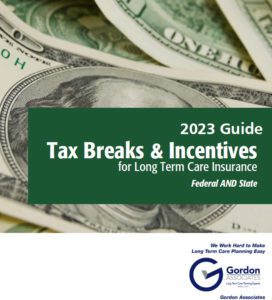As you age, retirement is a concept that moves from very fuzzy and nebulous to concrete and practical–slowly, at first, but then in a big hurry. As your future comes into focus, it’s important to consider the best ways to pay for–and protect–your retirement.
Long Term Care Insurance is a way to do that, hedging your bets against the uncertainty of your future–in much the same way that retirement accounts give you security over the long term. That’s why some clients now consider using their IRA to pay for their LTCI policies. There are certainly advantages to this. For example, the current tax rates for this kind of move are quite low. This means it’s easier than ever to turn both your IRA and LTCI into a symbiotic security blanket that can protect your retirement from the unexpected.
There are a few ways to use IRA assets to purchase LTCI–and there are benefits and drawbacks to each approach. This approach may not be for everyone, though, so be sure to talk to your financial advisory or LTCI Insurance specialist about your own situation.
What Happens When You Have a Long Term Care Event?
Like many healthcare-related expenses, you can’t really avoid long term care costs. If you have a long term care event, you’re going to need care. And because these long term care events aren’t usually predictable, it’s hard to know when you’ll need access to those funds.
Without Long Term Care Insurance:
- You’ll have to pay these funds yourself, out of your own pocket.
- Because these costs are unavoidable, you may need to use your retirement funds to pay for your care, draining your Traditional or Beneficiary IRA accounts.
- You will likely, therefore, deplete these retirement funds more quickly than you planned. And because you’re removing these funds sooner than you anticipated, you’ll likely also be at a tax disadvantage. Having a plan for taxes in retirement planning is important here.
That’s why using your IRA to purchase LTCI can be a smart way to control your costs and minimize your risks–especially if you’re going to have to use your retirement funds to pay for care anyway.
For Individuals with a Traditional IRA
So, let’s take a look at how this might work for an individual with a traditional IRA. Usually, people use these accounts to fund their retirement, either partially or fully. Once you reach age 73 (75 if you were born in 1960 or after), you’ll be required to start taking money out of your IRA (this is called a Required Minimum Distribution).
Many people will use this RMD to purchase LTCI, providing additional protection for their golden years. This RMD can be taken out as early as 59-and-a-half years old without a tax penalty.
For those under that age who want to look into LTCI funded via an IRA, there will be tax penalties involved. However, many clients will fund their LTCI in small parts over many years, decreasing the annual tax penalty involved (and making that easier to absorb). This means you’ll be able to plan for–and more easily absorb–the costs involved. Many LTCI policies (for example, hybrid plans) will lock in the premium price until the policy is paid up.
For Individuals with a Beneficiary IRA
It’s also common for individuals to inherit an IRA. Because of changes in the law under the CARES Act, beneficiary IRAs must now be used within 10 years. You can use the funds all at once or a little every year or anything in the middle. There’s still no penalty for those aged 59-and-a-half or over. Knowing how to plan for taxes in retirement accounts like this will be important.
If you’ve only got ten years to use your Beneficiary IRA account anyway, it makes sense to continue investing in your long term health and retirement plans. Consider using your IRA to fund a Long Term Care Insurance Policy–building more stability and security for your future. The benefits associated with LTCI won’t have the ten year cash-in date the way your Beneficiary IRA account will.
In this sense, you can honor the long-term intention of the original gift or Beneficiary IRA, and protect your financial future.
Benefits of LTCI
There are some significant benefits of Long Term Care Insurance, especially when purchased with your IRA:
- Your money works harder for you: in the financial world, this is called leverage: every dollar you pay in premium is worth more than one dollar in benefits. A $20,000 policy, for example, earns you far more than $20,000 in benefits over the long term.
- You can leave a bigger and better legacy: Medical expenses can drain your IRA, savings, and investments. LTCI can help prevent that, limiting your care costs–and making it easier to leave something to your children.
- If you invest in a hybrid plan, you may also gain access to life insurance benefits (depending on the formulation of your plan).
How to Plan for Taxes in Retirement Accounts
Using your IRA to purchase LTCI isn’t right for everyone. There’s no one-size-fits-all strategy, and everyone’s situation will be slightly different. That’s why we always recommend that people work with their financial advisor or LTCI specialist together. Having an estimate of the LTCI you may need can also help you plan more effectively.
Different insurance carriers will also offer different options–that’s why at Gordon Associates, we work with every patient on an individual basis. If something doesn’t make sense or it’s not the right fit for you, we’ll say so.
You can also bring in an accountant to help you navigate these questions–in terms of how they’ll impact your finances of today and tomorrow.
Hedge Your Bets and Consider Your Options
As you plan your future and consider your options, it’s important to remember that there will always be bumps in the road and unanticipated developments. You can’t plan for everything. But you can give yourself a hedge against risk–and a safety net–so you can fully enjoy your retirement.
Contact Gordon Associates today to talk about your financial future!


 To help determine if long-term care (LTC) insurance is right for you, we are offering a FREE informational guide. This is a comprehensive booklet that will answer many of your questions about tax breaks and incentives for LTCI for federal and state taxes.
To help determine if long-term care (LTC) insurance is right for you, we are offering a FREE informational guide. This is a comprehensive booklet that will answer many of your questions about tax breaks and incentives for LTCI for federal and state taxes. To help determine if long-term care (LTC) insurance is right for you, we are offering a FREE informational guide. This is a comprehensive booklet that will answer many of your questions about LTC and assist you with your health care planning.
To help determine if long-term care (LTC) insurance is right for you, we are offering a FREE informational guide. This is a comprehensive booklet that will answer many of your questions about LTC and assist you with your health care planning.